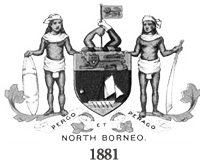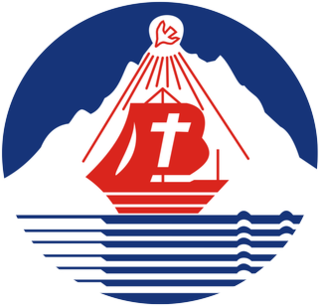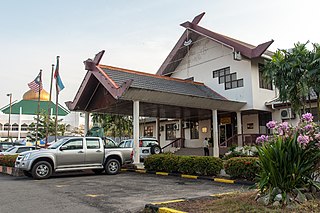
The North Borneo Chartered Company (NBCC), also known as the British North Borneo Company (BNBC) was a British chartered company formed on 1 November 1881 to administer and exploit the resources of North Borneo. The territory became a protectorate of the British Empire in 1888 but the company remained involved with the territory until 1946, when administration was fully assumed by the Crown colony government.

The Mat Salleh Rebellion was a series of major armed disturbances against the British North Borneo Chartered Company administration in North Borneo, now the Malaysian state of Sabah. It was instigated by Datu Muhammad Salleh, a local chief from the Lingkabo district and Sugut River. He led the rebellion between 1894 until his death in Tambunan in 1900. The rebellion then continued on for another five years until 1905.

The Interior Division is an administrative division of the state of Sabah, Malaysia. It occupies the southwest portion of Sabah, bordered by the neighbouring state of Sarawak on its west. With an area of 18,298 square kilometres, it covers 24.9% of Sabah's territory and is home to approximately 14.7% of Sabah's total population. The largest town in the Interior Division is Keningau. Other main towns in this division include Beaufort, Kuala Penyu, Sipitang, Tambunan and Tenom.

Keningau is the capital of the Keningau District in the Interior Division of Sabah, Malaysia. It is the fifth-largest town in Sabah, as well one of the oldest. Keningau is between Tambunan and Tenom. The town had an estimated population of 173,130. Dusuns, Muruts and Lundayehs is the major ethnics in Keningau.

Tenom is the capital of the Tenom District in the Interior Division of Sabah, Malaysia. Its population was estimated to be around 5,148 in 2010. It is located about 176 kilometres south of Kota Kinabalu and 128 kilometres north of Long Pasia, which is one of the famous attractions in Sabah. In the early days of British colonial rule in Malaysia, the town was called Fort Birch. The town is considered the unofficial capital of the Murut community, whose most important festival, the annual Pesta Kalimaran, is held in the town. It is also the main gateway to other areas within the Murut heartland and the minority of Lundayeh.

The Murut are an indigenous ethnic group, comprising 29 sub-ethnic groups inhabiting the northern inland regions of Borneo. The Murutic languages are a family of half a dozen closely related Austronesian languages. The Murut can be found mainly in Sabah, but also in Sarawak, Brunei, and Kalimantan, Indonesia.

Sabah State Railway (SSR) is a railway system and operator in the state of Sabah in Malaysia. It is the only rail transport system operating on the island of Borneo. The railway consists of a single 134-kilometre line from Tanjung Aru, Kota Kinabalu in West Coast Division to the town of Tenom, in the Interior Division. It was formerly known as North Borneo Railway.
Datuk Seri Panglima Stephen Robert Evans SPDK, JP was a politician, public administrator and author from Sabah, Malaysia.

The Basel Christian Church of Malaysia or BCCM, formerly known as Borneo Basel Self Established Church, is one of the four Lutheran bodies in Malaysia. In 2009 BCCM had 112 congregations nationwide and 63,000 baptised members. In 2023, BCCM had 64,500 members.

George Cathcart Woolley was a British colonial administrator in North Borneo in the early part on the twentieth century. Woolley was also an ethnographer and an ardent collector, and the Woolley Collections of photographs, diaries and other artefacts, bequeathed to the State Government of Sabah, formed the nucleus of Sabah Museum when it was founded in 1965.

The history of Sabah can be traced back to about 23–30,000 years ago when evidence suggests the earliest human settlement in the region existed. The history is interwoven with the history of Brunei and the history of Malaysia, which Sabah was previously part of and is currently part of respectively. The earliest recorded history of Sabah being part of any organised civilisation began in the early 15th century during the thriving era of the Sultanate of Brunei. Prior to this, early inhabitants of the land lived in predominantly tribal societies, although such tribal societies had continued to exist until the 1900s. The eastern part of Sabah was ceded to the Sultan of Sulu by the Sultan of Brunei in 1658 for the former helping a victory over Brunei enemies, but many sources stated it had not been ceded at all. By the late 19th century, both territories previously owned by Sultan of Brunei and Sultan of Sulu was granted to British syndicate and later emerged as British North Borneo under the management of the North Borneo Chartered Company. Sabah became a protectorate of the United Kingdom in 1888 and subsequently became a Crown colony from 1946 until 1963, during which time it was known as Crown Colony of North Borneo. On 16 September 1963, Sabah merged with Malaya, Sarawak and Singapore to form Malaysia.

Sedomon Gunsanad Kina MBE (1894-1966) was a native chief of Keningau, in North Borneo, who later became a politician in unified Malaysia. He was the son of Gunsanad Kina and the older brother of G.S Sundang.

The Jesselton revolt was a revolt by a resistance movement known as the Kinabalu Guerrillas, comprising local Chinese, indigenous peoples, Eurasian and Sikh Indian of Jesselton, North Borneo and led by Albert Kwok, against the Japanese occupying forces of North Borneo.

Sabah is the third most populous state in Malaysia, with a population of 3,418,785 according to the 2020 Malaysian census. It also has the highest non-citizen population, at 810,443. Although Malaysia is one of the least densely populated countries in Asia, Sabah is particularly sparsely populated. Most of the population is concentrated along coastal areas, with towns and urban centers seeing the most population growth.

The Beaufort District is an administrative district in the Malaysian state of Sabah, part of the Interior Division which includes the districts of Beaufort, Keningau, Kuala Penyu, Nabawan, Sipitang, Tambunan and Tenom. The population of Beaufort is composed mainly of Bisaya, Brunei Malays, Kadazan-Dusuns, Lun Bawang/Lun Dayeh, Muruts and Chinese. Bisaya are the majority ethnic, and the population is scattered around the town. The capital of the district is in Beaufort Town.

The Keningau District is an administrative district in the Malaysian state of Sabah, part of the Interior Division which includes the districts of Beaufort, Keningau, Kuala Penyu, Nabawan, Sipitang, Tambunan and Tenom. The capital of the district is in Keningau Town.Dusuns, Muruts and Lundayehs are the major ethnics in Keningau.

The Nabawan District is an administrative district in the Malaysian state of Sabah, part of the Interior Division which includes the districts of Beaufort, Keningau, Kuala Penyu, Nabawan, Sipitang, Tambunan and Tenom. The capital of the district is in Nabawan Town.

The Sipitang District is an administrative district in the Malaysian state of Sabah, part of the Interior Division which also includes the districts of Beaufort, Keningau, Kuala Penyu, Nabawan, Tambunan and Tenom. The capital of the district is in Sipitang Town. The ecotourism village of Long Mio and Long Pasia is located in this district, while the small town of Sindumin serves as a gateway to the state of Sarawak.

The Tenom District is an administrative district in the Malaysian state of Sabah, part of the Interior Division which includes the districts of Beaufort, Keningau, Kuala Penyu, Nabawan, Sipitang, Tambunan and Tenom. The capital of the district is in Tenom Town.Majority Tenom is Murut while Kadazandusun as well as Lundayeh are minorities in Tenom.


















